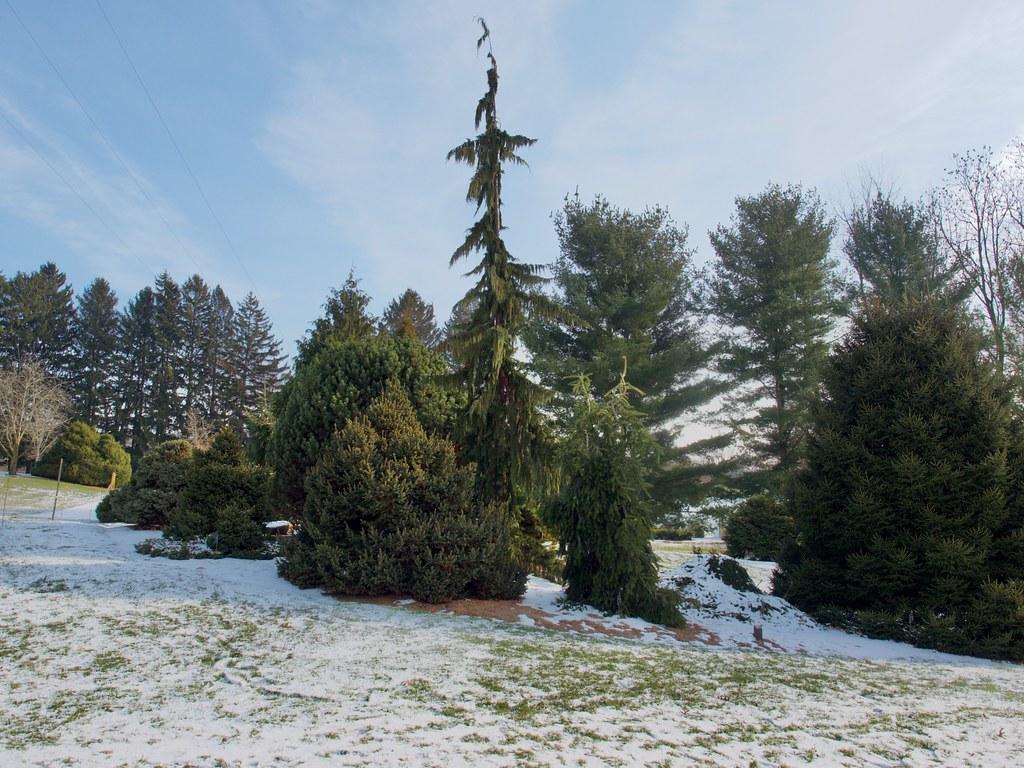
Pyramidalis Silver Fir (Abies alba ‘Pyramidalis’)
Also known as: Abies alba 'Pyramidalis'.
Pyramidalis Silver Fir (Abies alba ‘Pyramidalis’) is a coniferous tree species. Its narrow, elegant pyramidal shape makes it ideal for landscapes with limited space. This species features bright silver-green foliage year-round and distinctive yellowish brown cones that hold its unique shape for years. It also displays purple-tinged shoots in the spring and a showy red bark in the winter. Its slow growth and hardiness make it an ideal addition to any landscape. The Pyramidalis Silver Fir also requires minimal maintenance and can be an excellent companion for many other plants in the garden. From small yards to large gardens, this species will create a majestic and interesting landscape.
Interesting facts about the Pyramidalis Silver Fir:
- Distinctive Growth Habit: The most notable feature of Abies alba ‘Pyramidalis’ is its unique pyramidal shape. Unlike the regular European Silver Fir, which has a broader, more conical form, the Pyramidalis variant grows in a narrow, upright pyramid shape. This distinct growth habit makes it a popular choice for ornamental landscaping.
- Slow Growth Rate: The Pyramidalis Silver Fir is known for its slow growth rate, which makes it an ideal choice for small gardens or spaces where large trees can’t be accommodated. This slow growth also means it requires less pruning and maintenance compared to other faster-growing tree species.
- Dense Foliage: This cultivar has particularly dense foliage, with tightly packed, short needles. The dense foliage provides excellent cover and is often used in garden design to create a sense of privacy or as a windbreak.
- Adaptability to Varied Climates: While it retains many of the European Silver Fir’s hardy characteristics, the Pyramidalis variant is noted for its adaptability to a range of climatic conditions. It can thrive in both cold mountainous areas and milder climates, making it a versatile choice for different landscapes.
- Rare and Valued in Horticulture: The Pyramidalis variant is less common than the standard European Silver Fir, making it a prized specimen in horticulture. Its rarity and unique aesthetic appeal contribute to its desirability among garden enthusiasts and landscape architects.
- Minimal Cone Production: Unlike its parent species, the Pyramidalis Silver Fir is known for producing fewer cones. This can be an advantage in a garden setting, as it reduces the need for cleanup of fallen cones and seeds.
- Resistance to Pests and Diseases: This cultivar has shown a good resistance to many of the pests and diseases that typically affect fir trees. This resilience makes it a low-maintenance option for both private and public gardens, as well as urban plantings.
Plant care guide:
Watering
Water your Pyramidalis Silver Fir when the soil appears dry to the touch. The amount of water you give the plant will depend on the area's climate and the pot size in which it is growing. Generally, a good rule of thumb is to water the plant about every 7 to 10 days, giving it an inch (2 cm) of water at a time. If the weather is very hot and dry, you may wish to water the plant more often.
Sunlight
Pyramidalis Silver Fir Abies Alba 'Pyramidalis' will thrive in full sun, meaning 6 or more hours of direct sunlight each day. This species does best in bright, sunny locations, as it will not tolerate shade. It is important to provide it with the proper amount of light throughout the year, as too little sunlight can lead to stunted growth. During the summer months, it should receive full sun all day, while in the winter months it should receive at least 4 hours of direct sunlight each day.
Pruning
Pruning Pyramidalis Silver Fir Abies Alba 'Pyramidalis' should be done in late winter or early spring. When pruning, the goal should be to maintain the natural pyramidal shape of the tree. Remove any broken or dead branches, as well as any branches that are crossing or rubbing. Be sure to remove any branches that are growing inward toward the center of the tree. It is best to prune only small amounts at a time, removing no more than one-third of the tree’s foliage. This will ensure that the tree remains healthy and vigorous.
Plant information:
- Family: Pinaceae
- Type: Tree
- Height: ~9.14 meters
- Cycle: Perennial
- Growth Rate: Low
-
Anatomy:
- Leaves: dark-green
- Branches: dark-brown
- Twigs: brown
- Care Level: Medium
-
Watering:
- Average
- Every 7-10 days
- Sunlight requirement: full sun
- Pruning:
- February, March, April
- Propagation: Cutting, Grafting Propagation, Layering Propagation, Seed Propagation
- Origin: Austria, Germany, Switzerland, Italy, France, Slovenia, Croatia
- Seeds: No
- Drought Tolerant: No
- Salt Tolerant: No
- Thorny: No
- Invasive: No
- Tropical: No
- Indoor: No
- Flowers: No
- Cones: Yes
- Fruits: No
- Edible Fruit: No
- Leaf: Yes
- Edible Leaf: No
- Cuisine: No
- Medicinal: No
- Poisonous to Humans: No
- Poisonous to Pets: No
Sources & more information:
Content is based on public databases such as the KEW Plants of the World database, among others. Please double-check all information. "About Plants" does not take responsibility for any inaccuracies.
